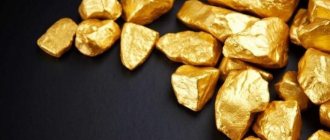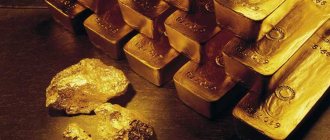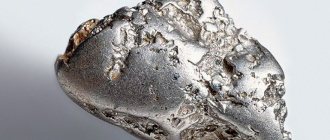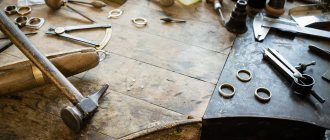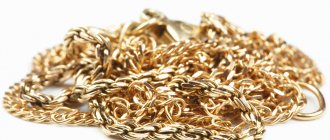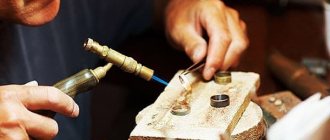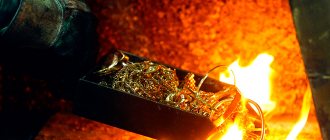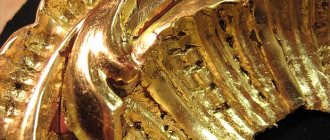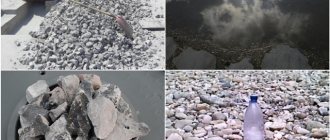With the advent of new technologies and cheaper materials, it has become much easier and cheaper to produce fake gold jewelry.
Naturally, it is better to buy gold jewelry new in a store. When purchasing, ask for a quality certificate and trade permit. Running into a fake is reduced to zero. What to do if you find, give, or offer a beautiful ring or earrings from someone else? There are cases when gold is used to pay for services and is offered in exchange for something. And at the same time it is less valuable than in the store. In these cases, it will not be superfluous to have instructions on how to check whether it is gold or not at home, using accessible means.
Visual inspection
Visual inspection boils down to checking the markings of the gold product. You need to find a sample and a distinctive sign of the manufacturer. The original product has all the details, the numbers are easy to read, and the stamping depth is the same. The size is barely readable.
At the top is a fake, at the bottom is a real gold ring.
Large numbers, the absence of a manufacturer's mark, and different depths of numbers should alert you. It is better to refuse such jewelry and not make a purchase.
Jeweler services as a reliable and safe way to verify the authenticity of metal
Traditional methods of metal testing are good as an express method. For reliability and confidence in the results, you should contact a professional jeweler. In his arsenal there will be all the necessary means of determining the authenticity of a gold product.
The jeweler always has the necessary tools at hand to test precious metals.
How to test gold with iodine
Attention! Do not test on visible areas of the jewelry.
For the test you need a bottle of iodine and a cotton swab. Apply a little iodine to a small area, watch the reaction of the drop:
- On a real gold item, iodine will not change its original color. The droplet size will remain virtually unchanged.
- Other metals that are passed off as gold will react with iodine. The drop will begin to discolor and decrease in size until it dries completely.
Just applied a drop of iodine.
On the fake, the drop became lighter, but the original (dark) shade of iodine remained on the gold. After waiting about a minute, remove any remaining iodine.
- A real gold piece should have a dark stain.
- On the fake there is a white spot, even a sort of whitening of the area where iodine was applied.
A drop of iodine was wiped away. There was a light spot on the fake, a dark spot on the gold.
To remove iodine stains, use a 30 percent sodium hyposulfite solution. Polish with toothpaste.
How to determine a sample
You can determine the sample at home. To do this, you need to prepare gold chloride, alcohol, and a pipette. The product is thoroughly cleaned of dirt, grease, and fingerprints. To do this, wipe thoroughly with a cloth moistened with alcohol. After the procedure, the alcohol should completely evaporate. Using a pipette, drop a small amount of gold chloride and apply it to the object being examined. Leave for five minutes.
For an alloy with a purity lower than 585, the stain from the solution will turn brown. Brass and an alloy of silver and copper will turn black in a couple of seconds. Gold 585 and higher will remain unchanged. If you need exact numbers and you won’t be able to find them out at home, you should contact a laboratory.
We recommend: How to sew a mask without a sewing machine in 2 minutes
Lapis pencil test
Silver nitrate, a lapis pencil, does not show any reaction on real gold.
To check, you need to moisten the tip of a clumsy pencil and run it over the sample being tested.
- Jewelry made from genuine gold will not change color where it comes into contact with a pencil.
- The fake will be revealed by darkening.
A blackened area on a fake from exposure to a lapis pencil (Stilus Lapidis).
Preparing for cleaning
Before you start exposing a product to chemicals, it is necessary to prepare it. Gold should be cleaned of dust and dirt. It is not recommended to use abrasive pastes and brushes for this: this can leave scratches on the surface of the metal, since gold is very soft. Therefore, it must first be soaked so that the dirt softens and some of it goes away on its own, and the remains can be easily removed using available materials.
Let's prepare a soap solution. To do this, take water with a temperature of about 60 degrees and add any detergent to it. This could be shampoo, dishwashing liquid, or regular soap. Do not use detergents containing alkali or acid.
Dip the gold item into the prepared solution and leave it there for several hours. After this, gently, without pressing, wipe hard-to-reach areas with a soft brush. If you use a soap solution, then the chance that dirt can be removed immediately with less damage to the metal surface is much higher.
Test with ammonia and vinegar
The method is similar to those carried out above - we check the reaction of the decoration to ammonia and vinegar.
For the test you need a cotton swab. We wet the stick in ammonia and rub it over the decoration being tested.
- No reaction is observed on the gold product; the color of the stick remains white.
- Ammonia will oxidize other metals. The fake will show itself by changing the color of the cotton swab. The stick takes on a distinct blue tint. Dark spots may appear on the fake.
Reaction of gold and counterfeit to ammonia.
To test with vinegar, you need to immerse the jewelry being tested in vinegar.
Stop! Don't waste time and vinegar on this test.
The method is not suitable for testing at home. The concentration of vinegar sold in stores is negligible to react with metals.
Question-answer section
How to wash a ring with cubic zirconia from iodine?
Expert opinion
Grishanov Mikhail Petrovich
Jeweler, director of the Grishanov and Co. workshop
Different types of stones can behave in special ways when in contact with an aggressive environment. The risk of ring damage increases if it contains natural stone inserts. Moreover, cubic zirconia requires special attention. To remove traces of iodine, prepare an aqueous solution of ammonia (1:1). It is applied carefully using a cotton swab.
Is it necessary to do sputtering after testing gold with iodine?
Expert opinion
Pribrezhny Gennady Valentinovich
Jeweler 6th category
If the ring is coated with a protective material, then when testing in one of the areas it will have to be damaged to ensure contact between the reagent and the gold. In addition, such actions will lead to the appearance of purple marks on the product. This means that it will take more effort and money to restore the original properties of the metal. First of all, the product is sanded; sometimes it is necessary to completely remove the old coating. After this, the ring is cleaned and prepared for re-application of the protective layer.
Gold jewelry and iodine
Is it necessary to test gold with iodine if it was purchased at a salon?
Expert opinion
Grishanov Mikhail Petrovich
Jeweler, director of the Grishanov and Co. workshop
You can pay attention to the parameters of gold jewelry in the store. The ring should have a characteristic shine, weight, and when it falls on a glass display case, it should produce a special ringing sound, like crystal. But if you still have doubts about the authenticity of the gold, you can ask for a certificate for the product. Most often, jewelry sold in salons is of high quality and corresponds to the stated parameters. This means that gold testing is not mandatory, especially since the procedure can ruin the appearance of the ring. It is carried out when the need arises, if there is a suspicion of low quality jewelry.
Water test, Archimedes method
For the test you need: high-precision scales, thread, measuring cup, water (distilled will give a more accurate result), a table of the density of materials.
Density of precious metals:
| Density/p | 9 — 10 | 11 — 12 | 12 — 14 | 14 — 17 | 19,3 |
| Metal/sample | Silver | Gold/375, 500 | Gold/583, 585 | Gold/750 | Gold/999 |
To make gold jewelry, an alloy of gold and other metals is used. To indicate the percentage of gold, jewelry is marked with a hallmark. The higher the standard, the more expensive the jewelry. Also, the higher the percentage of gold content, the higher the density of the entire product.
Archimedes' method is based on these features. How to take measurements:
- Weigh the product (m).
- Find the volume - put a glass of water on the scale, reset the weight (the scale should read 0). We lower the product being tested into the water on a rope (without touching the walls and bottom), and record the readings (v).
- Carry out the calculation using the formula - p = m / v.
- The resulting density (p) is compared with the table (density of precious metals).
For clarity, check out the video on density measurement:
Convenience of the method and its disadvantages
A household method of checking precious metal for authenticity using iodine:
Convenient and easy enough to use.
Does not require complex chemical reagents or special equipment.
It can be carried out by non-specialists; it is enough to carefully observe the reaction of the interaction of two elements.
The disadvantages include:
Checking only the surface part of the jewelry.
It is impossible to obtain a result with 100% accuracy.
It is impossible to check gold-plated products; the top layer of gold will be removed with sandpaper.
Difficulties also arise with rhodium-plated products, if a thin layer of rhodium is removed, a yellowish or reddish metal appears underneath it.
Chemical cleaning variations
After we have thoroughly washed our gold or silver and have not achieved the desired result - stains still exist - we proceed to radical cleansing measures. These measures are very effective compared to a solution of soap or powder.
Chemical products include ammonia solution, hydrogen peroxide, sodium thiosulfate, etc. Despite the complex names of some products, they are all very common and can always be purchased freely in pharmacies or hardware stores.
1. Ammonia. A favorite product of conscientious housewives for high-quality and quick cleaning of windows, adding shine to glass and crystal dishes. The excellent properties of ammonia - an alcoholic solution of ammonia - will also be useful for our procedure.
To carefully clean your favorite product, you need to dilute the concentration of the caustic substance. We will need moderately hot water, 10-20 ml of ammonia and any washing liquid to soften the solution. Again, you need to soak the jewelry in the resulting substance for several hours or even longer.
In this solution, silver may acquire an unnatural light shade. To enhance the effect, you can add hydrogen peroxide to ammonia - a powerful chemical that is used in a wide variety of areas of life: from stopping bleeding to bleaching laundry.
You can roughly calculate the concentration of the cleaning solution by taking equal parts of hydrogen peroxide and ammonia (a little - 20 milliliters each). Water should be added, bringing the volume of the solution to 100 ml, no more.
Chemical solutions consisting of several components are quite active chemical media, and precious items should not be left in them for a long time.
Therefore, leave the gold or silver for about 10 minutes, periodically removing and visually inspecting the item. If the stains have faded significantly, you can gently clean them with a cotton swab using the same solution.
2. Sodium thiosulfate (hyposulfite) is a very common pharmaceutical drug that has an antitoxic effect. The medicine is freely available in pharmacy chains and can be purchased at a low cost.
The drug is available in ampoules of 10 ml, it is very convenient to open one ampoule and mix with water in the following proportion: 1 ampoule per 0.5-1 glass of water. Soak the gold or silver for about half an hour and patiently wait for the reaction time.
We take out the jewel that is dear to our hearts and rinse it thoroughly under running water. As practice shows, the result can be very impressive. Your efforts will not be in vain - your jewelry will shine like new.
Your favorite chain will highlight the color of your skin, and its shine will be magnificent. A ring on a finger will casually highlight the beauty of the fingers and remind the owner of feminine charm and attractiveness...
But lyrical digressions aside, some interesting methods for cleaning precious metal await us.
Rules for wearing, caring for and storing gold jewelry
Gold jewelry should be worn carefully. Accessories designed to decorate the external image are recommended to be removed if there is likely exposure to foreign objects or kitchen fumes. A negative factor will be sudden temperature changes. In addition, the danger to jewelry is posed by:
- eau de toilette and deodorants;
- humid environment;
- contact with cutting, abrasive objects.
Places where jewelry is taken off:
- gyms;
- spa centers, beauty salons;
- baths and saunas, etc.
It is better to store your personal jewelry collection separately. When they come into contact, they leave scratches and become deformed. For this purpose, special velvet bags and cases have been created, similar to those found in jewelry stores. Jewelry accessories do not interact well in plastic, so it is better to avoid cases made of this material.
Excessive exposure to direct sunlight spoils jewelry. Therefore, they must be kept in a closed, dark space.
The most powerful cleaning products, or How to avoid a trip to the workshop
There is an even more sophisticated way to clean gold from iodine without resorting to the help of professionals, whose services are expensive and the results are unpredictable. We are preparing a real “hellish mixture”!
Don't be afraid of its ingredients; they are all individually quite harmless, at least for metals. You need to take regular soda - 2-3 tablespoons, 50-70 g of quicklime, a couple of tablespoons of sodium chloride (ordinary table salt) and one spoon of 9% vinegar.
Dissolve all components in hot water and bring to a boil. Then turn off the stove and lower our gold or silver into the hot mixture. We take it out and carefully examine our jewelry, repeating the process until it is completely restored.
How to clean jewelry with stones
Cleaning inlaid gold is a process that takes into account the type of stone and the method of its attachment. There are soft stones: amber, pearls. And hard ones - diamonds, sapphires, topazes.
Soft stones cannot withstand the aggressive environment created by ammonia and vinegar. The best cleaning option is water and alcohol. After exposure, wipe the product dry, because soft stones are hydrophobic.
If the inlay is held on by glue, the acidic environment will corrode it. In this case, wipe the contaminated area with a cloth soaked in the solution. Gloves must be used here. Products with hard stones can more easily withstand aggressive environments, so you don’t have to be “gentle” with them.
White gold
White gold looks especially luxurious. But it is precisely this that is the most capricious and requires individual care. It's all about his alloy.
The original color of the metal appears due to nickel, and the surface is pollinated with rhodium. But rhodium changes its original appearance over time; To preserve it, it is recommended to clean the product with a napkin.
To clean this metal, you cannot use tooth powder, paste, or hard brushes. Soap products and ammonia are effective.
There is a traditional method that has proven itself well. You will need half a glass of beer and an egg yolk. Mix the ingredients well. Dip the fabric into the resulting mixture and rub. Rinse and dry. Moisture has a negative effect on this metal.
